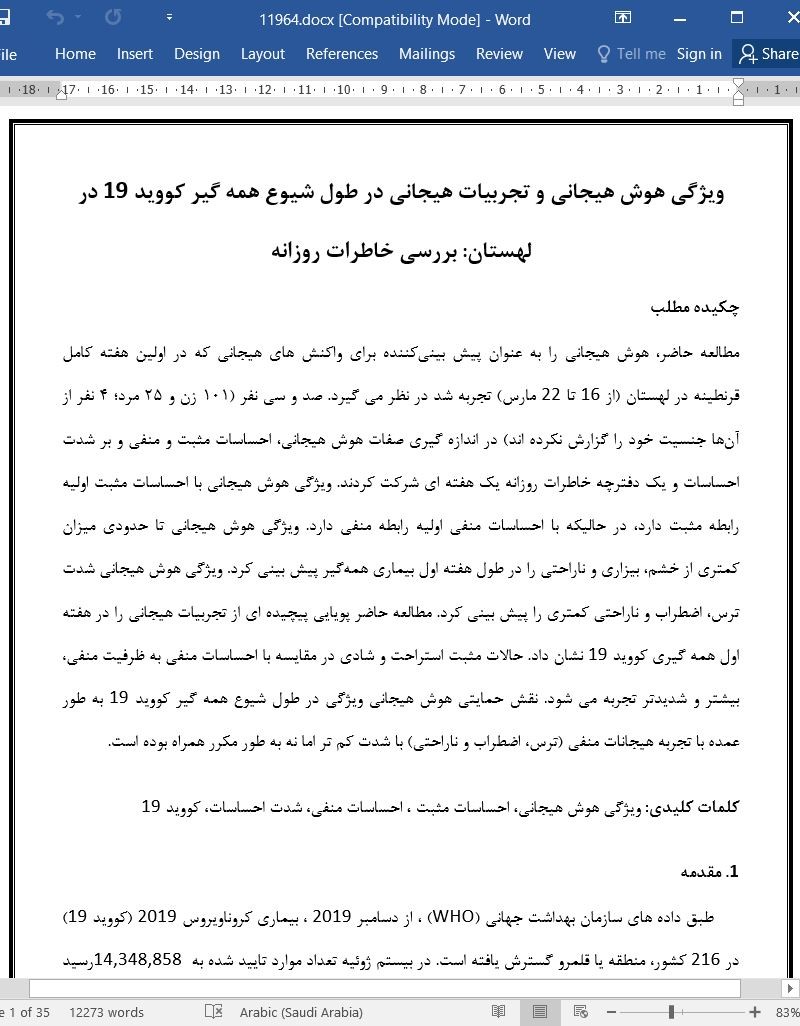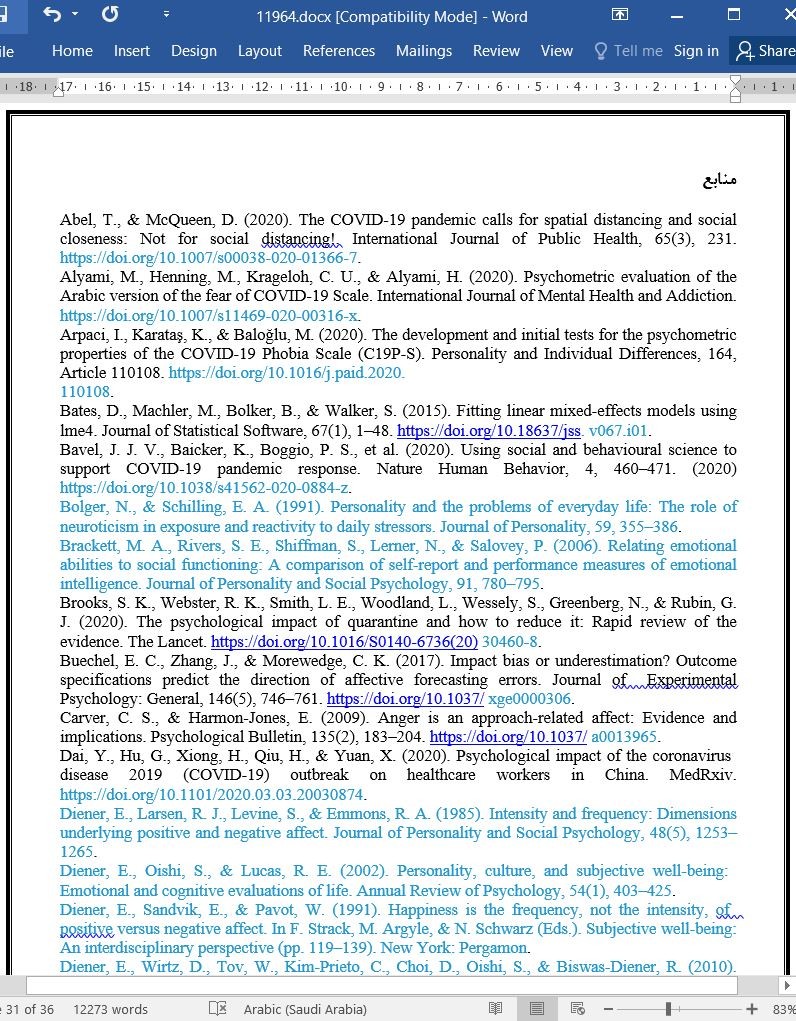
ویژگی هوش هیجانی و تجربیات هیجانی در طول شیوع همه گیر کووید 19
چکیده مطلب
مطالعه حاضر، هوش هیجانی را به عنوان پیش بینیکننده برای واکنش های هیجانی که در اولین هفته کامل قرنطینه در لهستان (از 16 تا 22 مارس) تجربه شد در نظر می گیرد. صد و سی نفر (۱۰۱ زن و ۲۵ مرد؛ ۴ نفر از آنها جنسیت خود را گزارش نکرده اند) در اندازه گیری صفات هوش هیجانی، احساسات مثبت و منفی و بر شدت احساسات و یک دفترچه خاطرات روزانه یک هفته ای شرکت کردند. ویژگی هوش هیجانی با احساسات مثبت اولیه رابطه مثبت دارد، در حالیکه با احساسات منفی اولیه رابطه منفی دارد. ویژگی هوش هیجانی تا حدودی میزان کمتری از خشم، بیزاری و ناراحتی را در طول هفته اول بیماری همهگیر پیش بینی کرد. ویژگی هوش هیجانی شدت ترس، اضطراب و ناراحتی کمتری را پیش بینی کرد. مطالعه حاضر پویایی پیچیده ای از تجربیات هیجانی را در هفته اول همه گیری کووید 19 نشان داد. حالات مثبت استراحت و شادی در مقایسه با احساسات منفی به ظرفیت منفی، بیشتر و شدیدتر تجربه می شود. نقش حمایتی هوش هیجانی ویژگی در طول شیوع همه گیر کووید 19 به طور عمده با تجربه هیجانات منفی (ترس، اضطراب و ناراحتی) با شدت کم تر اما نه به طور مکرر همراه بوده است.
1. مقدمه
طبق داده های سازمان بهداشت جهانی (WHO) ، از دسامبر 2019 ، بیماری کروناویروس 2019 (کووید 19) در 216 کشور، منطقه یا قلمرو گسترش یافته است. در بیستم ژوئیه تعداد موارد تایید شده به 14,348,858 رسید و تعداد مرگ ها به 603,691 نفر رسید (WHO، 2020). همه گیری کووید -19 ، توسط سازمان بهداشت جهانی در روز ۱۱ مارس اعلام شد، از لحاظ جنبه های جدی اجتماعی، سیاسی، اقتصادی و روانی، جمعیت زیادی را تحت تاثیر قرار داده است (هولمز و همکاران، 2020 ؛ هویی و همکاران، 2020). متخصصان توجه خود را به بیمارانی جلب کردند که ممکن است به طور خاص نیازمند مداخلات خاص داشته باشد، یعنی افراد مسن و کارگران مهاجر بین المللی (لیم، وانگ، واریانتی، لاتکین، و هال ، 2020 ؛ یانگ و همکاران، 2020). با این حال، شیوع بیماری های عفونی مانند کووید 19 می تواند باعث ناراحتی شدید هیجانی، ترس از بیماری، اضطراب، افسردگی و خشم حتی در افرادی شود که در معرض خطر ابتلا به این بیماری قرار ندارند (دای، هو، شیونگ، کیو، و یوان، 2020 ؛ دوان و ژو، 2020 ؛ هوانگ و ژائو، 2020 ؛ مونتمورو، 2020). واکنش مداخله در بحران های روانی پیشنهاد شده کووید 19 بر حفظ ثبات عاطفی، مقابله با ترس، نظارت بر ناراحتی و بهبود مقابله تمرکز داشت (ژانگ، وو، ژائو، و ژانگ، 2020). درک عاطفی و تنظیم هیجانات، پیش نیاز بسیاری از مداخله های فوق بود. بنابراین، ویژگی هوش هیجانی به عنوان ساختاری که شامل پردازش کارآمد و مدیریت نشانه های هیجانی است (مایر و سالووی، 1997) ، ممکن است به عنوان یک عامل محافظتی مهم در مواجهه با بیماری های همه گیر در نظر گرفته شود.
Abstract
The study examined trait emotional intelligence as a predictor for emotional reactions experienced during the first full week of the lockdown in Poland (from 16th to 22nd March). One hundred and thirty persons (101 women and 25 men; 4 did not report their gender)participated in the baseline measurement of trait emotional intelligence, positive and negative affect, and affect intensity and in a one-week daily diary. Trait emotional intelligence correlated positively with baseline positive affect and positive intensity, while negatively with baseline negative affect and negative intensity. Trait emotional intelligence marginally significantly predicted a lower frequency of anger, disgust, and sadness during the first week of the pandemic. Trait emotional intelligence predicted a lower intensity of fear, anxiety and sadness. The study showed a complex dynamics of emotional experiences during the first week of the COVID-19 pandemic. Positive states of relaxation and happiness were experienced more frequently and more intensely compared to the negatively-valenced emotions. The protective role of trait emotional intelligence during the COVID-19 pandemic outbreak was mainly associated with experiencing negative emotions (fear, anxiety, and sadness) less intensely, but not less frequently.
1. Introduction
According to the data of the World Health Organization (WHO), since December 2019, the coronavirus disease 2019 (COVID-19) has spread to 216 countries, areas or territories. On July 20th the number of confirmed cases reached 14,348,858 and the number of deaths amounted to 603,691 (WHO, 2020). The COVID-19 pandemic, declared by the WHO on March 11th, has deeply affected large populations in terms of serious social, political, economic, and psychological aspects (Holmes et al., 2020; Hui et al., 2020). Experts drew attention to patient populations that may particularly need tailored interventions, i.e. older adults and international migrant workers (Liem, Wang, Wariyanti, Latkin, & Hall, 2020; Yang et al., 2020). However, infectious disease outbreaks such as COVID-19 can cause severe emotional distress, fear of the disease, anxiety, depression, and anger even in people who are not at high risk of the disease (Dai, Hu, Xiong, Qiu, & Yuan, 2020; Duan & Zhu, 2020; Huang & Zhao, 2020; Montemurro, 2020). Recommended psychological crisis intervention response to COVID-19 was focused on maintaining emotional stability, confronting the fear, monitoring distress and improving coping (Zhang, Wu, Zhao, & Zhang, 2020). Emotional understanding and emotion regulation were the prerequisites of many of the above interventions. Therefore, trait emotional intelligence, as a construct that encompasses efficient processing and managing emotional cues (Mayer & Salovey, 1997), may be regarded as a significant protective factor in the face of the pandemic.
چکیده مطلب
1. مقدمه
1. 1. تاثیر کووید 19 بر سلامت هیجانی و روانی افراد
1. 2. ویژگی هوش هیجانی و تجربیات هیجانی
1. 3. نقش فرکانس و شدت تجربیات هیجانی
1. 4. رویکرد عواطف گسسته
1. 5. مطالعه حاضر
2. روش ها
2. 1. شرکت کنندگان
2. 2. معیارها
2. 3. فرآیند
3. نتایج
3. 1. آمار توصیفی برای اندازه گیری خط پایه
3. 2. رگرسیون های چند سطحی
4. بحث
مطابقت با استانداردهای اخلاقی و موافقت رسمی
رضایت آگاهانه
تمجید از مسئولیت های نویسندگان
اعلان منافع رقابتی
منابع
Abstract
Keywords
1. Introduction
1.1. The COVID-19 impact on emotional and mental health of the public
1.2. Trait emotional intelligence and emotional experiences
1.3. The role of frequency and intensity of emotional experiences
1.4. Discrete emotions approach
1.5. The present study
2. Method
2.1. Participants
2.2. Measures
2.3. Procedure
3. Results
3.1. Descriptive statistics for baseline measurement
3.2. Multilevel regressions
4. Discussion
Compliance with ethical standards ethical approval
Informed consent
CRediT authorship contribution statement
Declaration of competing interest
References
- اصل مقاله انگلیسی با فرمت ورد (word) با قابلیت ویرایش
- ترجمه فارسی مقاله با فرمت ورد (word) با قابلیت ویرایش، بدون آرم سایت ای ترجمه
- ترجمه فارسی مقاله با فرمت pdf، بدون آرم سایت ای ترجمه



